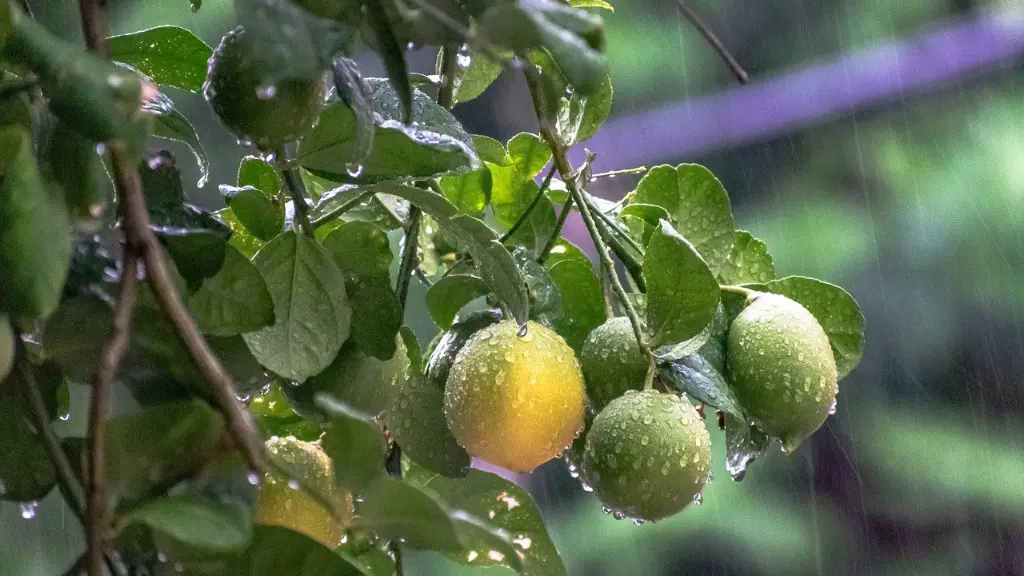Can you buy a lemon tree? Yes, lemon trees can be bought from most home and garden stores or nurseries. It’s important to remember that while you can purchase a lemon tree, it is not always a guarantee that it will never bear fruit. The climate in which the lemon tree is planted plays a major role in its success rate. Lemons thrive in tropical and subtropical regions with a warm climate and plenty of humidity. The type of tree you buy will also make a difference in how successfully it produces fruit. Dwarf lemon trees are typically recommended for indoor use.
When it comes to buying a lemon tree, there are several factors to consider. The cost of the lemon tree will greatly depend on the type of variety you decide to purchase. Standard lemon trees are generally more expensive than dwarf trees, since they require more space and care. Additionally, you will need to factor in the cost of soil, fertilizer, and any other potential materials necessary for proper planting and maintenance. Furthermore, most lemon trees require a certain amount of sunlight per day, so it is important to find a location for your tree that will provide the ideal amount.
In order to grow a successful lemon tree, it is also important to have the correct type of soil. Generally, it’s best to use potting soil mixed with compost and aged manure to help maintain optimal soil conditions. Furthermore, a well-draining soil is essential for the lemon tree to thrive. In order to create a well draining soil mix, peat moss can be added for extra aeration.
Growing a lemon tree also requires constant dedication and care. For example, lemon trees should be watered on a regular basis. The water requirements will depend on the type of climate and ground in which the lemon tree is planted. For best results, it is generally recommended to water the lemon tree with a hose or watering can, making sure not to overwater the plant. Additionally, weeds should be removed on a regular basis to ensure that the lemon tree has the best chance at achieving growth and ultimate success.
When choosing a lemon tree, it is important to select one of the most suitable varieties. Each type of lemon tree will have different requirements for care and space. For example, some lemon trees, such as the Meyer lemon, can be grown in containers indoors, while other types, such as the Lisbon lemon, need to be planted in the ground in order to produce fruit. Therefore, it is important to know exactly what type of lemon tree you are buying in order to ensure success.
Fertilizing Lemon Trees
In order for a lemon tree to reach its full fruiting potential, it is important to provide it with the correct amount of fertilizer throughout the year. Fertilizing a lemon tree will help replenish essential nutrients found in the soil, providing the tree with the nutrients that it needs to produce healthy and abundant fruit. There are a few different types of fertilizers that are recommended for optimal growth, such as organic fertilizers, slow-release fertilizers and liquid fertilizers. Each type has its own benefits and it is important to understand which type is most suitable for your particular lemon tree.
Organic fertilizers are a good choice for the more health-conscious gardener. These types of fertilizers help to promote natural growth and can add extra nutrients to the soil. Examples of organic fertilizers include compost, seaweed and fish emulsion. Slow-release fertilizers are also an option, as they provide a more gradual and consistent supply of nutrients over an extended period of time. Liquid fertilizers can also be used, and they provide rapid nutrients to the lemon tree. However, these types of fertilizers can also be quite damaging to the soil, and it is important to use them with caution.
When using any type of fertilizer, it is important to consult the instructions provided. Fertilizers are typically applied once every two months during the growing season. Additionally, it is important to apply the fertilizer evenly around the base of the lemon tree and avoid contact with the leaves. Finally, it is important to water the tree thoroughly after fertilization in order to ensure the nutrients are properly absorbed into the soil.
Pruning Lemon Trees
Pruning is an important part of the care and maintenance of a lemon tree. Pruning often encourages more fruitful growth and helps maintain a stronger frame. Pruning involves cutting away dead, diseased or damaged branches, as well as branches that are growing in an unruly or non-fruitful manner. It is important to use sharp, clean pruning shears when pruning a lemon tree, in order to avoid any damage to the tree.
In order to stimulate the growth of new branches and encourage more fruitful growth, it is best to prune the tree in late winter or early spring. This way, the tree has ample time to heal and grow before the summer seasons. It is also important to prune away any suckers or water sprouts that may be growing beneath the canopy of the lemon tree. These can inhibit the growth of more fruitful branches.
When pruning, it is best to remove no more than one-third of the tree at a time. Pruning too heavily can cause stress to the tree and prevent it from bearing fruit. It is also important to note that pruning too early in the season can reduce the productivity of the lemon tree. Therefore, it is best to consult a professional or gardening guide to find the optimal pruning times for your particular tree.
Protecting Lemon Trees
In order to ensure that a lemon tree will produce fruit, it is important to protect it from any potential dangers. It is best to keep an eye out for any signs of disease or pests, such as aphids, mites, caterpillars, or scale. If these pests are present, it is important to take the necessary steps to exterminate them as quickly as possible. Additionally, if frost is present in the winter months, it is important to cover the lemon tree to prevent any damage.
Another method of protection for lemon trees is pruning away any diseased branches or branches that have been exposed to pests or disease. This will help limit the spread of diseases and keep the lemon tree healthy. Additionally, if there are any slow-growing or weak branches, they can be removed in order to promote selective growth.
Finally, in order to protect the lemon tree from any potential cold spells, it is important to provide adequate shelter. This can be done by planting the tree in an area with direct sunlight or by wrapping it in burlap during the winter months. Additionally, it is best to avoid any exposure to wild animals or other potential dangers. These steps will help ensure that the lemon tree has the best chance of producing a healthy and fruitful crop.
Harvesting Lemon Trees
When harvesting a lemon tree, it is important to wait until the lemon is ripe and the color has changed from green to yellow. It is best to harvest the lemon by hand, as this will prevent any damage to the branches. Before harvesting the lemon, it is important to gently twist and pull the lemon from the branch; this will help ensure that the stem is not damaged in the process.
Once the lemons have been harvested, it is important to store them in a cool and dry location. This will help ensure that the lemon will last longer and limit the potential of mold growth. Additionally, it is important to store the lemons away from direct sunlight and any other potential sources of heat. This will help keep the lemons fresh and prevent them from drying out.
Lemons stored in the refrigerator or a cool place can last up to one month, while lemons placed in a warm place will last just a couple of days. Lemons can also be frozen in order to extend their lifespan. Frozen lemons will last up to several months and can be used in many different recipes.
Diseases Lemon Trees
Citrus trees, including lemon trees, are at risk of various different types of diseases which can disrupt their growth and development. The most common diseases include citrus diseases, root rot and yellowing leaves. Citrus diseases are caused by bacteria and fungi which can develop on the bark and leaves of the tree, causing subtle changes in color, texture and appearance. Root rot is caused by fungus in the soil which builds up and prevents the roots from absorbing proper nutrients.
Another common issue with lemon trees is yellowing leaves. The yellowing of the leaves is caused by a lack of iron and nitrogen in the soil. It is important to ensure that the soil is checked regularly for proper nutrient levels, and that the lemon tree is given supplemental iron treatments in order to prevent yellowing. Additionally, it is important to monitor the lemon tree for any signs of disease or pests, as these can quickly spread and cause damage to the tree.
If any diseases or pests are present, it is important to take the necessary steps to remove them as quickly as possible. Various fungicides and insecticides are available to treat these issues. Additionally, if any yellowing of the leaves is present, supplemental iron treatments can be used to promote healthy growth. Finally, it is important to keep the soil moist and avoid overwatering, as this can create the perfect environment for various diseases.




